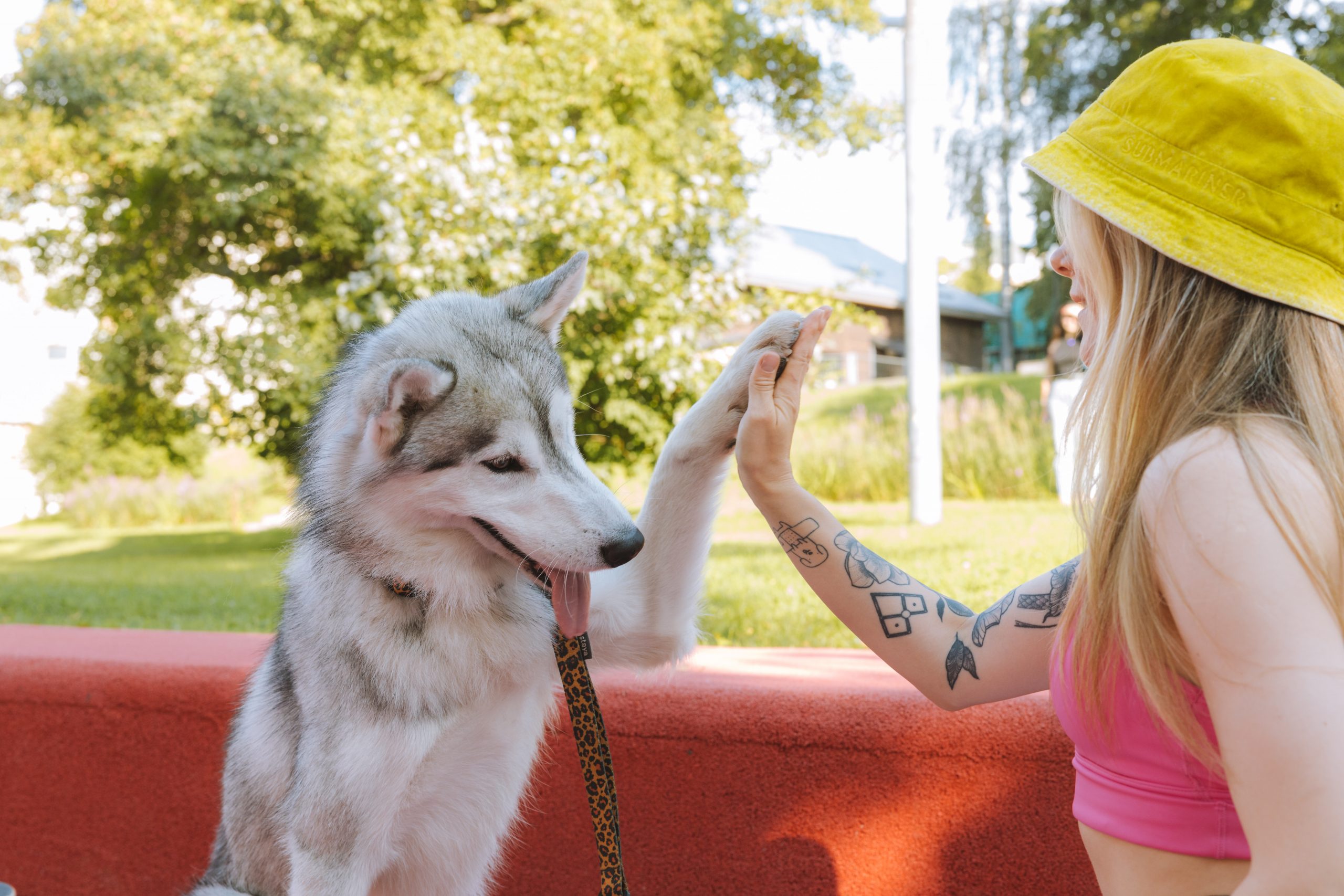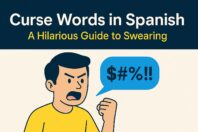Dog Commands in Spanish: Our Top 22 Spanish Dog Commands

Get our free email course, Shortcut to Conversational.
Have conversations faster, understand people when they speak fast, and other tested tips to learn faster.
More infoWe all love our furry friends, and how could we not? With their cute little paws and boopable snouts, it’s impossible not to give in to them. Dog training is an essential way to give them love, as it allows us to communicate with them and strengthen bonds and make them feel more secure.
Teaching your good boy to follow basic dog commands in Spanish is a great way to expand your Spanish vocabulary while bonding with your pupper. And as a bonus, it’s a cool opportunity to impress your friends while you’re at it. It’s a win-win, really.
Today, we’ll cover 22 dog commands in Spanish for you to try out. We’ll start with the simplest and most common dog training commands, and work our way through to the harder ones.
And now a word from the dog
Before we begin, let’s ask ourselves the basic question: do dogs understand English or Spanish? True, your puppies might understand when you say sit or come, but will they understand the same dog commands in Spanish when you start saying siéntate and ven aquí?
In reality, when it comes to dog phrases, the key is just that you learn how to speak dog language! So as long as you’re looking for commands to teach your dog, you may as well choose to teach them some common dog commands in Spanish rather than English!
And if you want to go all out and raise your four-legged friend bilingual, you could even give your new puppy a Spanish dog name!
Commands in Spanish: The Imperative form
Just as in English, all types of commands in Spanish use the imperative mood. In this post on Spanish dog commands we’ll just focus on the words and phrases, so for a thorough explanation of the Spanish imperative tense we recommend our detailed post on Spanish commands. And just in case you’re also dealing with kids, we’ll also leave you with this post of tú commands for teachers and babysitters.
Dog words in Spanish
First of all, do you know how to say dog in Spanish? Whether your four-legged friend is a chihuahua, a xoloitzcuintli, or a golden retriever, in Spanish we can refer to any breed of dog as a perro. We use the feminine form for a female dog in Spanish: perra.
As in English with cuter diminutives like pupper or doggie, in Spanish we often refer lovingly to our furry friend as a perrito or perrita. These work just as well when referring to puppies, though technically puppy in Spanish is cachorro or cachorra.
And since we’re getting into dog training commands here, you’ll probably need to bribe your pups a fair amount in the process: dog treats in Spanish are called premios.
Spanish dog commands
Ok now that we’ve covered the basics of talking about dogs in Spanish, it’s time to start learning how to speak dog… Let’s dive in and get to know the top 22 dog commands in Spanish!
No: No command in Spanish
This basic dog command is essential to set limits. This command is often combined with other verbs for more specific commands. However, dogs are very smart and a simple no is usually enough for them to understand that they must stop what they are doing. Let’s take a look at how to teach a dog no in Spanish:
- Spots, no! – ¡Manchas, no!
- Don’t run, Skipper! – ¡No corras, Skipper!
- Don’t eat that, Princess! – ¡No comas eso, Princesa!
Perro malo: Bad dog in Spanish
If telling our dog no isn’t enough, sometimes we need to add another dog word for some discipline. Although using these phrases may make us a little sad, they’re still important for telling the doggies when they’ve done something wrong. Note that we acknowledge gender when addressing individual dogs, so we include both masculine and feminine forms here:
- Bad dog. – Perro malo. Perra mala.
- Bad boy. Bad girl. – Chico malo. Chica mala.
Sí: Yes command in Spanish
This isn’t necessarily a command, but it comes in handy to reinforce positive behaviors and to make our pets feel loved. Sí is often combined with other phrases to give your dog even more love and confidence.
- Yeah, good dog, Toto! – ¡Sí, buen perrito, Toto!
- Yes! Well done, Max! Who’s a good boy? – ¡Sí, bien hecho, Max! ¿Quién es un buen chico?
Buen perro: Good dog in Spanish
We already included a couple of examples of how to say what a good dog in the last section, so let’s list each of them here. You can combine these phrases with sí to praise your dog, in case you are wondering how to tell your dog you love them in Spanish.
- Good boy. Good girl. – Buen chico. Buena chica.
- Good dog. – Buen perro. Buen perrito.
- Who’s a good boy? Who’s a good girl? – ¿Quién es un buen chico?, ¿Quién es una buena chica?
- Well done! – ¡Bien hecho!
- Good job. You’re a good girl, Nana. – Buen trabajo. Eres una buena chica, Nana.
Mírame: Look at me in Spanish
Puppies can be very lively creatures, which can make it difficult for them to stay focused sometimes. Teaching them this command will help you direct their attention to you to make it easier to continue your training in Spanish with other commands and tricks.
- Look at me, Balto. That’s it! – Mírame, Balto. ¡Eso es!
- Hey, here, look at me! – Oye, aquí, ¡mírame!
Siéntate, Sentado, Sentada: Sit in Spanish
This one’s a classic and is very useful in combination with other commands, though there are a few forms to be familiar with. How do you say sit in Spanish for dog training? Siéntate is the imperative form of the reflexive verb sentarse, so siéntate is the classic version for telling your dog to sit down in Spanish.
Once your dog is sitting and you want her to stay sitting, you calmly tell her sentada. For a male dog, you tell him sentado to keep him sitting. At this point it’s probably time to offer the good boy some delicious treats, or premios!
Nonetheless, sometimes people use the latter two versions of the sit dog commands in Spanish for their perros and perras. In this sense, we tell our dogs sentado and sentada when we want them to be seated.
- Rocky, sit. Yes, sit. Good boy! – Rocky, siéntate. Sí, sentado. ¡Buen chico!
- I just taught Toto how to sit. Look: Hey, Toto, sit! – Acabo de enseñarle a Toto cómo sentarse. Mira: Oye, Toto, siéntate.
Ven aquí: Come here in Spanish
When your doggo’s running amok at the dog park and you want to call come in Spanish, you’ll use these simple dog words: ven aquí. In English, this command translates literally as come here. Ven aquí is one of the Spanish dog commands with a few English equivalents, so you’ll also say ven aquí when you want to tell your dog come on in Spanish, get over here in Spanish, or simply come here in Spanish.
- Golfo, come here! – ¡Golfo, ven aquí!
- Don’t go that way, Maya! Come here! – ¡No vayas por ahí, Maya! ¡Ven aquí!
Vamos a pasear: Let’s go for a walk in Spanish
Doggies always get excited when they hear vamos because it means it’s time to go out. You can combine vamos with other basic dog commands in Spanish, like a pasear which translates as to go for a walk, or el paseo which simply means a walk, and you can bet they’ll start wagging their waggy tails. Too cute!
- Let’s go, Bianca, for a walk! – ¡Vamos, Bianca! ¡A pasear!
- Time for a walk. Let’s go, boys! – Hora del paseo. ¡Vamos, chicos!
Heel command in Spanish – Junto
When you’re walking your dog, you can use the heel command so that they stay by your side. We know that sometimes they may see things on the street that catch their attention and make them wander a little (like squirrels, cats, or other dogs), so learning this heel dog command is always useful when you’re out. Heel in Spanish is junto, which translates literally as “together.”
- Don’t walk away, Pluto. Heel. – No te alejes, Pluto. Junto.
- Heel, Percy. Come here. – Junto, Percy. Ven aquí.
Quieto, Quieta: Stay in Spanish
When dogs are meeting other pets or people, they can get very excited or even a little anxious. To prevent them from misbehaving or getting hurt, learning how to train a dog to stay is a must. It’s also very useful to teach them to relax around very stimulating things like food and toys.
When we tell a dog to stay in Spanish, we use the form to reflect their gender, so either quieto or quieta. When it’s ok for them to go again, you can release them with the command listo.
- Muñeca, stay. Wait. Release. Good girl! – Muñeca, quieta. Espera. Listo. ¡Buena chica!
- No, Doki, stay! That’s it. – ¡No, Doki, quieto! Eso es.
Trae, Tráelo, Tráela: Fetch in Spanish
Dogs love to play fetch, especially if it involves a ball. There’s nothing like a ball to keep a dog happy, entertained, and active.
As you can see, this is one of the dog commands in Spanish that has a few variations. The two versions with direct object pronouns attached both translate as fetch it, depending on the gender of the thing fetched. How do you say ball in Spanish, for example? La pelota is a feminine noun, so we would say tráela. On the other hand, el juguete is a masculine noun meaning the toy in Spanish, so we would use tráelo. To just tell the dog to fetch, you can simply use trae.
- Bingo, do you want the ball? Go on! Fetch! – ¿Bingo, quieres la pelota? ¡Allá va! ¡Tráela!
- Fetch the toy, Layla! Fetch it! – ¡Trae el juguete, Layla! ¡Tráelo!
Suelta, Suéltala, Suéltalo: Give, Drop, or Drop it in Spanish
Whether you’re playing fetch and your furry buddy is reluctant about dropping the ball, or they’ve picked up something dangerous, you’ll want to use this command to tell your dog give it to me in Spanish. Doggies can be very naive and pick up things they shouldn’t, so it’s important to teach your dog to drop it.
This is another of the Spanish dog commands that changes depending on the gender of the object, just like we saw previously for fetch in Spanish. We use suelta in general to just tell our dog give, or we can use either suéltalo or suéltala for masculine or feminine objects to say give it to me in Spanish.
- Loki, what’s in your mouth? Drop! – Loki, ¿qué tienes en la boca? ¡Suelta!
- Did you fetch the ball? Good job! Drop it! – ¿Trajiste la pelota? ¡Bien hecho! Suéltala.
Habla: Speak in Spanish
This trick is simply adorable and sure to delight more than one when they see that you know how to teach your dog to speak. In Spanish we use the imperative form of the verb hablar, which means to speak, so we tell our pupper ¡habla!
This trick takes some patience to get right since we humans don’t know how to speak dog, and usually results in a very excited pup in the process. But at least with the habla command you now know how to teach a dog to speak in Spanish!
- C’mon, buddy, speak! – Vamos, amigo, ¡habla!
- I taught my dog how to speak. Molly, speak! – Le enseñé a mi perro a hablar. Molly, ¡habla!
Silencio: Quiet in Spanish
Sometimes our doggos can make quite a racket. Although we know they mean no harm, sometimes it can be too much and that’s when you’ll want this command to call for some calm in Spanish. Translated literally, silencio means silence, though quiet is probably the more common dog command. As a bonus with this Spanish command, you can also use it on humans!
- Shhh, Georgie! Quiet! – ¡Shhh, Georgie! ¡Silencio!
- Stop barking, Bruno! Quiet! – ¡Deja de ladrar, Bruno! ¡Silencio!
Abajo: Lie down or Get down in Spanish
Abajo translates as down, so this Spanish dog command is what people use to order their puppies to get off the furniture or the guests. In addition, some people use the abajo to get their pet to lie down. So abajo can be used for both of these basic dog commands in English.
- Lulu, you know you can’t be on the sofá. Get down! – Lulú, sabes que no puedes estar en el sofá. ¡Abajo!
- Down, Poncho. Let me see your cute belly! – Abajo, Poncho. ¡Déjame ver tu linda pancita!
Échate, Echado, Echada: Lie down in Spanish
Échate, echado, and echada contrast with abajo, which can have two uses in English, in that these Spanish dog commands are used exclusively to tell our pups to lie down. This is one of those easy dog tricks that takes some practice to get right, but it’s always a fun one for both you and your pet.
Like others we’ve seen so far, these Spanish dog commands come in three forms depending on whether we’re acknowledging our dog’s gender when we give the command. The neutral command form in Spanish for lie down is simply échate.
- Sit. Good girl! Now, lie down. Well done! – Siéntate. ¡Buena chica! Ahora, échate. ¡Bien hecho!
- No, Bobby! Lie down. That’s right! – ¡No, Bobby! Echado. ¡Eso es!
- Luna, lie down! Good dog! – ¡Luna, echada! ¡Buena perrita!
De pie, Arriba: Stand and Up commands in Spanish
With these Spanish dog commands you can teach your furry friend how to get up and walk on two legs like a human. Who doesn’t like to see that?
¡De pie! basically means on your feet!, while ¡arriba! means up!. We put these two Spanish dog commands in the same section here since they’re often used together.
- Boots, up! Stand up! – ¡Botas, arriba! ¡De pie!
- Stand up, puppy! – ¡De pie, perrito!
Salta: Jump in Spanish
It’s more than obvious that we all like to see doggies doing tricks, or we wouldn’t be here. And if you know how to teach your dog to jump, this is one of the most awe inspiring ones. Many people often combine this with equipment like hoops and sticks to jump through and over, which is awesome.
To teach your dog to jump is one of the advanced dog tricks, so be patient and focus on teaching your pet the simpler commands and tricks first.
Salta is the command form of the Spanish verb saltar: to jump. Used as dog training commands in Spanish, these same words can also mean jump over, depending on the dog tricks.
- We are ready to win the competition. Jump over the stick, Mimi! Jump! – Estamos listos para ganar la competencia. ¡Salta el palo, Mimi! ¡Salta!
- I’m teaching my dog to jump through the hoop. Bubu, jump! – Estoy enseñándole a mi perro a saltar por el aro. ¡Bubu, salta!
A la cama, A la casa: Go to your bed, Go home commands in Spanish
If you’re in a situation where you need your puppy to stay somewhere specific, this command is ideal. Whether you want to train your dog to go to their bed, to go back home, or go somewhere else, you can modify this command to fit the location you need. Let’s see a few examples:
- Daisy, to your bed. Stay there. – Daisy, a la cama. Quédate ahí.
- Captain, what are you doing here? Go home! – ¿Qué haces aquí, Capitán? ¡A casa!
- Lucho, go to the backyard! C’mon. – ¡Lucho, al patio! Vamos.
- Kari, go outside. – Kari, afuera.
La Pata, La Patita, Dame La Pata, Choca Los Cinco: Paw command in Spanish
This paw command in Spanish is often combined with other basics like siéntate, and is a nice way to show how smart and well trained your precious canine is. Since paw in Spanish translates as pata, the first three Spanish dog commands here are to directly ask your dog for their paw. La patita is the diminutive, since we often speak in cuter terms with our doggos, while dame la pata is the longer version of give me your paw.
Some people even teach their dogs to high five them with choca los cinco, which is always accompanied by big smiles on both humans and dogs.
- Ada, paw! That’s it, good girl! – Ada, la pata! ¡Eso es, buena chica!
- Duchess, sit and give me your paw. Yeah, that’s it! – Duquesa, siéntate y dame la pata. ¡Sí, eso es!
- Polly, high five! Excellent! – ¡Polly, choca los cinco! ¡Excelente!
Rueda: Roll over in Spanish
If you like to rub your puppy’s tummy, rueda is one of the best commands to teach your dog. Rodar is the Spanish verb for to roll or to roll over, so with rueda you give the command for your dog to roll over in Spanish.
We’re getting pretty advanced with our dog tricks here, so think about combining rueda with siéntate, dame la pata and échate to put together the most adorable sequence worthy of many treats!
- My dog knows a lot of tricks, like rolling over, for example. Come on, Susy, roll over! – Mi perrita sabe muchos trucos, como rodar, por ejemplo. ¡Vamos, Susy, rueda!
- I like to see my dog’s tummy. Roll over, Leon! – Me gusta ver la pancita de mi perro. ¡Rueda, León!
Hazte el muerto, Hazte la muerta: Play dead in Spanish
If you think your dog has acting talent, this play dead trick is sure to work wonders. You can get creative here, as some dogs fake really impressive deaths. You can also change the command to a sound and a motion, such as a fake gunshot with your fingers to add more drama to the whole thing!
We use the imperative of the verb hacer here, meaning to do or to make in Spanish, in its reflexive form hacerse. Hazte is the imperative form, translating as make yourself, hence hazte el muerto. El muerto and la muerta are gender specific for the dead, so you’ll choose between these two dog commands in Spanish based on whether you have a perro or a perra.
- My dog is very smart. She knows how to play dead. Look: Chiqui, play dead. – Mi perra es muy inteligente. Sabe hacerse la muerta. Mira: Chiqui, hazte la muerta.
- Lie down, Dandy. That’s it! Now, play dead. – Échate, Dandy. ¡Eso es! Ahora, hazte el muerto.
Conclusion
It’s always fun to see dog-related topics, isn’t it? And it’s even better when you can pair it with your love for the Spanish language! Before we say goodbye, let’s do a little review of what we saw today, shall we?
We started by talking a little bit about the importance and benefits of training your dog in Spanish, and concluded that it’s a great opportunity to learn more vocabulary and also to practice it with your pet. Then we introduced our top 22 dog commands in Spanish, with explanations and examples showing how to use each one.
The Spanish dog commands are generally ordered by difficulty, so the easiest and most basic dog commands came first. Remember that the Spanish verb tense we used in each one is the imperative, so we’ll again recommend you refer to our dedicated post on commands in Spanish so you can get creative and create some of your own dog commands in Spanish.
Feel free to share or bookmark this post so you can come back to it whenever you need some inspiration on new commands to teach your dog. In the meantime, we wish you and your dog good luck with the training. And most of all, we wish you and your furry friends to have fun!



